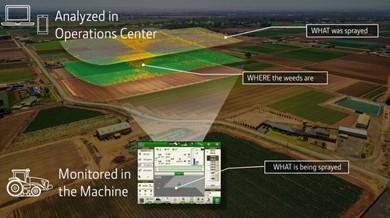John Deere faces the same dilemma of other equipment manufacturers: prepping for a long-term future filled with agricultural sustainability demands on energy, soil and water while also keeping in mind investors and Wall Street players focused heavily on short-term earnings.
To that point, while top Deere officials were meeting on April 5 with reporters and analysts at a new test farm outside Austin, Texas, to show off the latest in combines and autonomous tractors, Deere shares dropped from $394 to $373 amid a 9% decline over the five days prior to April 6 . The stock is down more than 11% over the last year as well.
Many factors could have been involved in the stock’s sudden decline, analysts said, everything from fuel prices to crop prices, but that decline does not take away from the heavy focus Deere places on the future, with research into machine learning and field testing of its autonomous tractor introduced last year. The company has learned a lot as one of the nation’s oldest: it was founded in 1837 and now employs 82,000 workers with $52.5 billion in 2022 revenues.
At its premier Tech Summit in Austin, Deere officials drilled the audience with slideware and lectures on its use of data to help with precise planting and its research into soil biology and lithium batteries for future tractors and construction machines.
For its sustainability initiatives, Deere is focused on new and cleaner diesel engines, biofuels, electric-diesel hybrids and all-electric vehicles. Deere is also in the early stages of trying to develop two critical technologies for real-time soil analyzing and real-time plant analyzing.
“These technologies could have a huge impact not only on crop health and production but also water usage and groundwater management,” Tirias Research Principal Analyst Jim McGregor told Fierce. “From a tech perspective, Deere is focused on a complete data solution that includes all the resources used for ag. It’s impressive—the breadth of the company from both an ag and tech perspective.”
Deere is “definitely headed in the right direction, but the challenge is defining the business model going forward,” McGregor added. It turns out that Deere is facing the same challenges facing the auto industry.
“Deere’s efforts will have a significant impact on farm production and resource utilization, especially water and chemicals, but the challenge is finding an economical and consistent way for the average farmer to pay for it. Hence, the business model,” McGregor said.
RELATED: Texas farmer tells ag tech’s role in staving off disasters, improving yields
Several analysts at the Tech Summit suggested Deere could do more with hydrogen energy. “There is considerable effort to use hydrogen in marine, trucking and power generation,” McGregor said. “I believe it could be critical for farming as well, but solving the local generation and transportation issues will be no small feat.”
Deere and Tech Summit attendees also talked about potentially using virtual reality more heavily in coming years, even to have VR incorporated in autonomous tractor use or with automated farm implements like planters and sprayers.
RELATED: John Deere updates its 186-year ag tech mission with precision machines, flair
Steady as she goes
Another analyst, Maurice Klaehne at Counterpoint Research, said Deere’s sheer size and enormous global customer base mean it will take time for farmers to adapt to new, expensive technologies and to realize the eventual productivity gains.

"Deere is taking strides to further ag tech, but it does so in a very steady and strategic way,” he Klaehne said. “There may be more cutting-edge solutions being developed by others but Deere’s strength lies ion the ability to executive diligently due to its size and resources, moving the market along at a pace that is comfortable for most customers in the space.”
New Deere technologies were in evidence at the Tech Summit, including See & Spray and ExactShot which rely on robots and edge compute power to help reduce the use of herbicides and fertilizers. Such innovations show off Deere’s commitment to furthering precision ag, eventually all the way down to individualized care for each plant at mass scale, Klaehne added.
(Here's a short video clip showing See & Spray in action spraying water instead of a herbicide. The wind was gusty the day of the demonstration. )
“It takes a long time to change behavior in farming, so I don’t expect any largescale changes in ag to happen quickly, but Deere continues to move forward along this path,” Klaehne said. “Deere is also showing commitments to sustainability with more electric or hybrid electric equipment coming out by 2026.”
To enable many of the autonomous capabilities Deere has introduced, strong wireless connectivity Is critically important. Last fall, Deere began a process to seek proposals for low-Earth orbit satellite connectivity to help drive autonomous machines in areas of the world where terrestrial communications are missing. That RFP is in its final stages, Deere reported.
In one example, huge swaths of Brazil have wireless gaps and where satellites would help. Deere estimates only 20%-30% of Brazil has cellular communications, and mostly in cities away from farms.
Because of its climate and soil, Brazil often has three growing and harvest seasons in a year compared to one or two seasons in the US. Better connectivity would ensure Brazilian farmers they could harvest and then plant the same field almost immediately, Deere officials said. Because the country feeds 800 million people and is the globe’s top soybean producer, efficient ag production is critical, the company said.
“Billions of dollars of value for technology solutions can’t exist if the tractor is not connected,” said Jonny Spendlove, senior product manager at Deere.
RELATED: John Deere cultivates data business with 500,000 connected machines